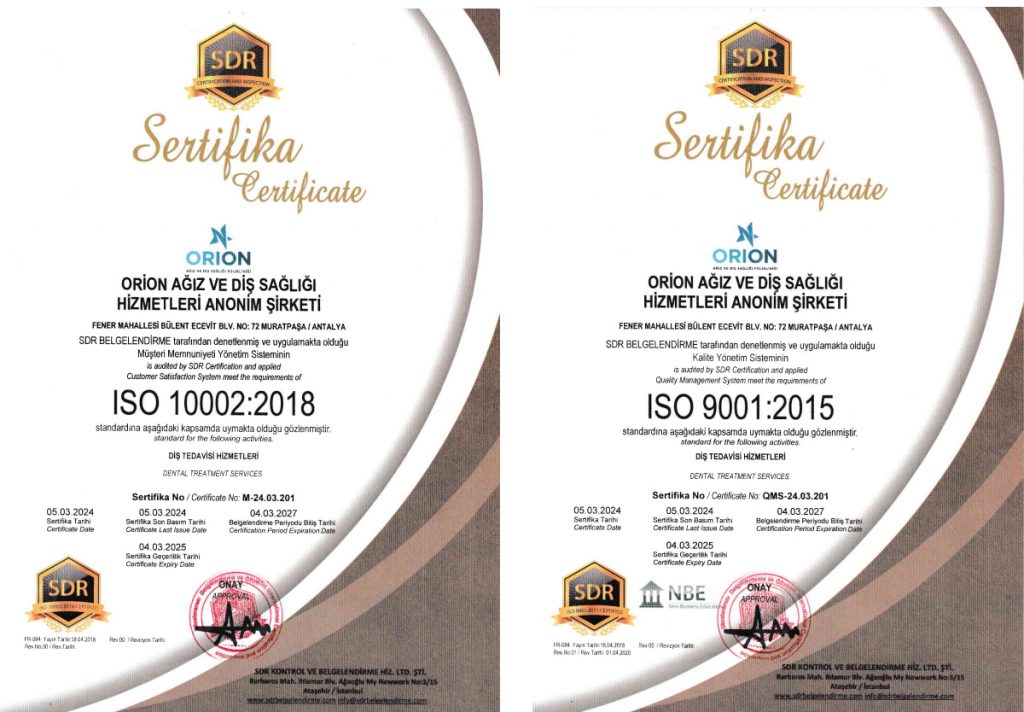- Fener Mah. Bulent Ecevit Blv. No:72 Muratpasa/ANTALYA

Teeth whitening is a safe and very popular procedure used to improve the color of natural teeth and is a great way to brighten your smile. There are a number of suggested ways to whiten teeth, but we only perform scientifically proven and safe treatments at the ORION ORION AND DENTAL HEALTH CENTER. The degree of bleaching can be determined by photographs taken before and after the bleaching process.
The main purpose of this treatment is to reach the areas where toothbrushes cannot reach and to provide cleaning. Thanks to this process, the teeth are cleaned much better. It is frequently used to clean food and beverages such as tea, coffee and cigarettes that we use frequently in our daily life. During this process, the yellowing on the tooth is removed by spraying.
It is the process of removing the tartar formed on the teeth. Hot or cold substances should not be consumed for 24 hours after the procedure. Sensitivity to heat and cold may be experienced in the teeth for a few days. There is no harm in taking painkillers to prevent pain. Gargling with a mixture of warm water and salt can be good. Dental cleaning should continue without interruption. You should go to the dentist regularly for control. 6-month periods are suitable for this.
In home-type teeth whitening application, a personal tooth whitening plaque is prepared with the measurement taken from the lower and upper jaws of the patients. The dentist chooses the tooth whitening gel suitable for the patient and the dosage is adjusted. Teeth whitening gel is placed in molds for the specified time (4-6 hours a day) and attached to the teeth. Generally, teeth whitening application is done at night because it is more practical. Teeth whitening application continues for 1-2 days depending on the degree of tooth discoloration. Hot-cold tooth sensitivity that may develop during the tooth whitening process is eliminated by fluoride application to the teeth.
Office-type teeth whitening is a method that provides faster and more effective teeth whitening applied by the dentist in the clinic. The gums are isolated with preservatives and high concentrations of tooth whitening agents are applied to the teeth. By activating the teeth whitening substance with special light devices, it is ensured that the bleaching process is performed.
These special light devices and laser devices cannot perform the bleaching process alone. The task of these devices is to activate the teeth whitening substance. The office type teeth whitening process takes up to 1 hour in total with 2 30-minute sessions. It is a safe method. It does not harm tooth enamel. Individuals with erosion or cracks in their teeth may experience sensitivity in the teeth. These complaints are eliminated with fluorine applications. After teeth whitening, tooth-coloring foods such as tea – coffee – cigarette – coke – red wine should be avoided.
Is Tooth Bleaching Harmful?
Studies have shown that bleaching has no harmful effects on teeth and surrounding tissues. Fluoride application can be applied to the patient to prevent sensitivities that may occur after bleaching. Sensitivity will disappear completely within 1-2 days after the application. In other words, teeth and gums are not damaged due to the teeth whitening process.
Does Sensitivity Occur As a Result of Teeth Whitening?
Tooth decays, tooth cracks, broken areas in teeth may cause tooth whitening gel used to create tooth sensitivity through these areas. Such dental problems must be eliminated before tooth whitening. In our clinic, we use products of the Opalescence brand of Ultradent, one of the most important companies in the world. At the same time, we can perform bleaching processes with the Zoom model of Philips brand.
How Long Does Office Type Teeth Whitening Last?
Depending on how careful and attentive the person carries out after the teeth whitening process, the permanence period varies between 2-3 years.
How Should Nutrition Be After Teeth Whitening?
After both application methods, tea, coffee, cola, cherry juice, red wine etc. Colored beverages and foods (such as very tomato paste, spicy dishes) should be avoided, especially smoking. Teeth should be brushed regularly, at least twice a day. Although it varies from person to person, a slight temporary tooth sensitivity may occur. Extreme cold or heat should be avoided for the first week. On the first day, the patient is recommended to use painkillers.
The teeth that have undergone root canal treatment and changed color are whitened by the dentist in the clinic. In the first session, a cavity is prepared just like filling the tooth inside the tooth and a bleaching drug is placed in this cavity. It is closed with filling. After about 1 week, the color of the tooth is checked. If sufficient tooth whitening is achieved, the procedure is terminated. If a little more whitening is desired, the medicine put into the tooth is changed and 1 more week is waited. If there is a color change in the teeth with root canal treatment, there will be a lighter color with the tooth whitening process.
These types of tooth discoloration are discolorations caused by the rupture of capillary blood vessels in the coronal part of the tooth after a severe trauma and by the blood cells entering the dentin tubules due to the Fe-sulfide (iron-sulfide) they contain. In cases where the tooth is alive, it can recover spontaneously, although rarely. However, if the tooth is necrotic (lost its vitality), there will be no improvement in color. In this case, teeth are whitened with bleaching agents applied to the pulp chamber after root canal treatment.
Caries on the tooth surfaces also cause various discolorations in the teeth.
These colorations are generally seen as gray, brown and black, rarely white, opaque colored areas. These staining are treated by cleaning the decay areas and using filling materials that are close to the natural color of the tooth.

Copyright © 2022 Orion. Tüm Hakları Saklıdır.